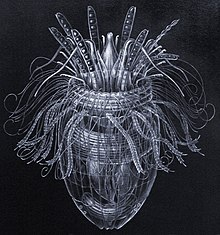Loricifera
| Loricifera | |
|---|---|

| |
| Pliciloricus enigmatus | |
| Klasifikasi ilmiah | |
| Kerajaan: | |
| Filum: | Loricifera
|
| Ordo: | Nanaloricida Kristensen, 1983[2]
|
| Familia dan genera | |
Loricifera (dari bahasa Latin, lorica, corselet (baju besi) + ferre, menanggung) adalah filum hewan laut yang tinggal di sedimen dari yang sangat kecil sampai mikroskopis dengan dua puluh dua spesies dijelaskan, dalam delapan genera.[3][4] Selain spesies yang dijelaskan, ada sekitar 100 lebih yang telah dikumpulkan dan belum dijelaskan.[3] Ukuran mereka berkisar dari 100 µm sampai kira-kira 1 mm.[5] Mereka dicirikan oleh wadah luar pelindung disebut lorika dan habitat mereka, yaitu di ruang antara kerikil laut di mana mereka menempel. Filum itu ditemukan pada tahun 1983 oleh Reinhardt Kristensen, di Roscoff, Prancis.[6] Mereka adalah salah satu kelompok yang paling baru ditemukan dari Metazoa.[7] Mereka melekatkan diri mereka cukup kuat pada substrat, dan karenanya tetap belum ditemukan untuk begitu lama.[4] Spesimen pertama dikumpulkan pada 1970-an, dan kemudian dijelaskan pada tahun 1983.[7] Mereka ditemukan di semua kedalaman, dalam jenis sedimen yang berbeda, dan di semua lintang.[4]
Spesies sunting
Armorloricus sunting
- Armorloricus davidi Kristensen & Gad, 2004
- Armorloricus elegans Kristensen & Gad, 2004
- Armorloricus kristenseni Heiner, 2004
Australoricus sunting
Nanaloricus sunting
- Nanaloricus khaitatus Todaro & Kristensen, 1998
- Nanaloricus mysticus Kristensen, 1983
Phoeniciloricus sunting
- Phoeniciloricus simplidigitatus Gad, 2004
Pliciloricus sunting
- Pliciloricus cavernicola
- Pliciloricus corvus Gad, 2005
- Pliciloricus dubius Higgins & Kristensen, 1986
- Pliciloricus enigmaticus Higgins & Kristensen, 1986
- Pliciloricus gracilis Higgins & Kristensen, 1986
- Pliciloricus hadalis Kristensen & Shirayama 1988
- Pliciloricus leocaudatus Heiner & Kristensen, 2005
- Pliciloricus orphanus Higgins & Kristensen, 1986
- Pliciloricus pedicularis Gad 2005
- Pliciloricus profundus Higgins & Kristensen, 1986
- Pliciloricus senicirrus Gad, 2005
- Pliciloricus shukeri Heiner & Kristensen, 2005
Rugiloricus sunting
- Rugiloricus carolinensis Higgins & Kristensen, 1986
- Rugiloricus cauliculus Higgins & Kristensen, 1986
- Rugiloricus ornatus Higgins & Kristensen, 1986
- Rugiloricus polaris Gad and Arbizu, 2005
Titaniloricus sunting
- Titaniloricus inexpectatovus Gad, 2005
Referensi sunting
This article incorporates CC-BY-2.0 text from references.[8][9] Characteristics cited from: Ramel, Gordon. "The Brush Heads (Phylum Loricifera)." The Earth Life Web. Web. 03 Mar. 2011.<http://www.earthlife.net/inverts/loricifera.html>.
- ^ Peel, J. S.; Stein, M.; Kristensen, R. M. B. (2013). "Life Cycle and Morphology of a Cambrian Stem-Lineage Loriciferan". PLoS ONE. 8 (8): e73583. doi:10.1371/journal.pone.0073583.
- ^ Kristensen, R. M. (2009). "Loricifera, a new phylum with Aschelminthes characters from the meiobenthos1". Journal of Zoological Systematics and Evolutionary Research. 21 (3): 163–180. doi:10.1111/j.1439-0469.1983.tb00285.x.
- ^ a b Gad, G. 2005. Successive reduction of the last instar larva of Loricifera, as evidenced by two new species of Pliciloricus from the Great Meteor Seamount (Atlantic Ocean). Zoologischer Anzeiger. 243: 239–271.
- ^ a b c Ruppert, Edward E., Richard S. Fox, and Robert D. Barnes. Invertebrate Zoology. 7th ed. Toronto: Brooks/Cole — Thomson Learning, 2004. 776.
- ^ Heiner, I. 2005. Preliminary account of the loriciferan fauna of the Faroe Bank (NE Atlantic). Biofar Proceedings 2005: 213–219.
- ^ Heiner, I., Kristensen, R.H. 2005. Two new species of the genus Pliciloricus (Loricifera, Pliciloricidae) from the Faroe Bank, North Atlantic. Zoologischer Anzeiger. 243: 121–138.
- ^ a b Kristensen, R.M. (2002). "An Introduction to Loricifera, Cycliophora, and Micrognathozoa". Integrative and Comparative Biology. 42: 641–651. doi:10.1093/icb/42.3.641.
- ^ Mentel, M.; Martin, W. (2010). "Anaerobic animals from an ancient, anoxic ecological niche". BMC Biology. 8: 32. doi:10.1186/1741-7007-8-32.
- ^ Danovaro, R.; Dell'Anno, A.; Pusceddu, A.; Gambi, C.; Heiner, I.; Kristensen, R. M. (2010). "The first metazoa living in permanently anoxic conditions". BMC Biology. 8: 30. doi:10.1186/1741-7007-8-30.